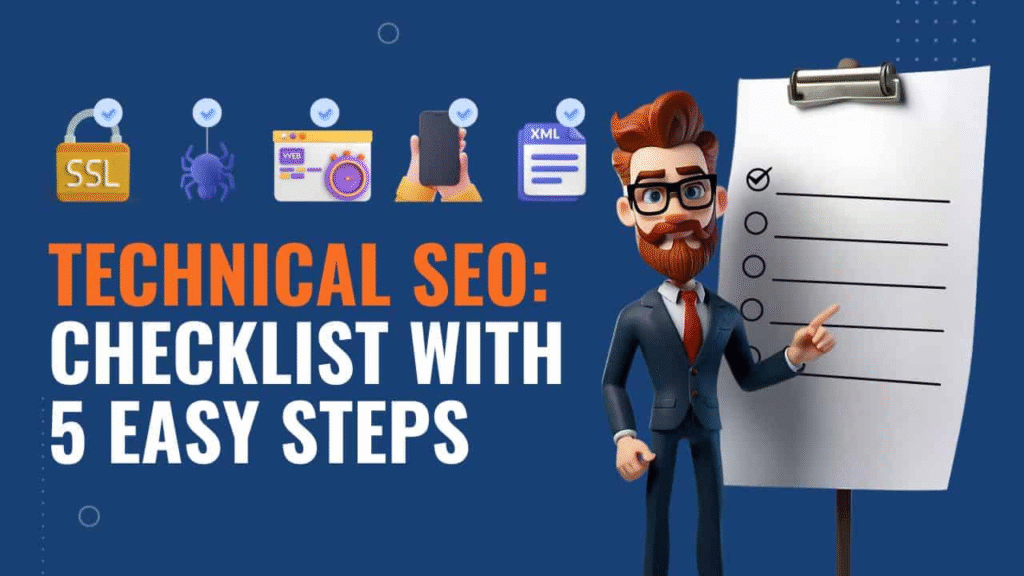A complete technical SEO checklist for WordPress websites covering site speed, mobile usability, indexing, structured data, and more. improve your site’s performance and search engine rankings.
In digital marketing, content may be king, but without a solid technical SEO foundation content won’t rank. For WordPress website users, learning about Technical SEO will help improve online visibility, enhance user experiences, and increase loading speeds.

What Is Technical SEO?
Technical SEO encompasses the steps you take in optimizing the framework of your site to enable effective crawling, indexing, and rendering of your pages by search engines.
On-page SEO is more centered on content, while technical SEO includes site architecture, performance and speed, site security, user-friendliness for mobile users, and much more. Content management is a breeze on WordPress, but in the absence of proper technical SEO, site ranking will be significantly aggravated.
.Importance of Technical SEO for WordPress
.Boosts speed optimization (a ranking factor)
.Guarantees mobile optimization
.Allows search engines to crawl and index pages to avoid wasted resources and phantom pages.
.Improves overall security of the site
.Resolves issues with crawling the site and broken hyperlinks
WordPress Websites Complete Technical SEO Checklist
You will find below the complete list of tasks of Technical SEO that you need to implement on your WordPress site.
Install an SEO Plugin
The first step is to install a powerful SEO plugin like:
Yoast SEO
Rank Math
These tools automate a lot of the manual work done during technical SEO, like:
Generating meta tags
Creating XML sitemaps
Providing breadcrumbs
Writing canonical URLs
Editing the robots.txt file
Enable a Clean and SEO-Friendly URL Structure
Access:
WordPress Dashboard → Settings → Permalinks
Select:
“Post name” — this is clean and keyword rich.
Avoid: striveslution.com/?p=123
Use: striveslution.com/technical-seo-checklist-wordpress
Submit an XML Sitemap to Google Search Console
An XML sitemap is a document that outlines URLs to be crawled by Google.
Steps:
Yoast or Rank Math installation
Locate sitemap URL (yoursite.com/sitemap_index.xml)
Access Google Search Console
Add sitemap in the “Sitemaps” section.
Check Your Robots.txt File
The robots.txt file set limitations that restrict some designated areas for a website.
Doesn’t restrict important directories like /wp-content/ or /wp-includes/
Permits Googlebot visitation
Editing is done easily via the SEO plugin.
Use HTTPS with an SSL Certificate
Google treats HTTPS as a ranking factor.
Verify that your website is accessible with https://
If it’s not:
Apply for a complimentary SSL certificate through Let’s Encrypt with your hosting provider
Set up the Simple SSL plugin to handle the redirect from http to https
Increase Site Speed & Performance
Users, as well as Google, pay attention to page speed.
You can utilize the following tools:
PageSpeed Insights
GTmetrix
Pingdom
To make speed improvements:
Switch to a lighter theme (Astra, Hello Elementor)
Image compression (ShortPixel, Smush)
Cache activation (WP Rocket, W3 Total Cache)
Content Delivery Network (CDN) activation (Cloudflare)
Optimize Mobile Usability
Make sure your website functions well on mobile devices as Google uses mobile-first indexing.
Test your site with Google Mobile-Friendly Test.
Element overlap
Text sizing
Text readability
Button sizing
Correct Redirect Mistakes and Broken Links
User experience and crawlablility are both negatively impacted due to broken links.
Broken Links Check
Ahrefs
Screaming Frog
Rank Math and redirection plugins can be used to create the needed 301 redirects.
Implement Canonical Tags
With duplicate content, Google gets confused as to which page is the main one, providing which canonical tag tells Google which page is the main page solves this.
Good SEO plugins, such as Yoast and Rank Math, automatically add these.
Augment Schema Markup
Rich results such as stars and FAQs can be generated with the aid of Schema, aiding Google in comprehending your content further.
Utilize the Rank Math or Schema Pro to implement the following:
Article Schema
Local Business schema
Product schema (if you have items for sale)
Define an Internal Linking Strategy
Enhance crawlability
Distribute link equity
Help direct users within your site
Use relevant anchor text and ensure every page is accessible within 3 clicks.
Prepare Your Site For Core Web Vitals
Core web vitals are:
LCP(Largest Contentful Paint)
FID (First Input Delay)
CLS (Cumulative Layout Shift)
You can improve these by:
Loading images lazily
Cutting down on JavaScript
Reducing layout shifts Periodically Review Your Technical SEO
Google Search Console
Ahrefs / SEMrush Site Audit
Screaming Frog
WP Rocket reports
Rank Math SEO Analysis
These are some tools you can use for recurring audits.
If You can service for WordPress website SEO please contact Me